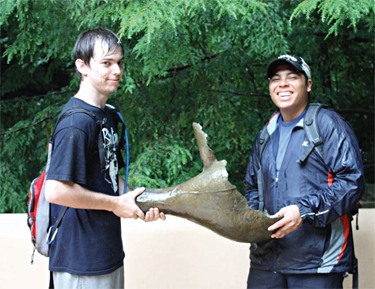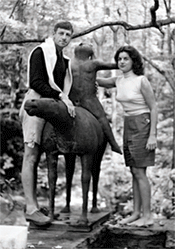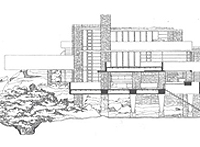Lost Art Found: A Remarkable Discovery at Bear Run

Adam Crider and Seth Weible display their find — the right hindquarter of Horseman.
It’s not every day that someone finds buried treasure, and one would hardly expect to find lost artifacts buried under the silt of a stream in Western Pennsylvania. Still, every once in a while something that has been assumed lost forever turns up when you least expect it — which is exactly what happened in August to Seth Weible, a Fallingwater tour guide.
Marino Marini’s Horseman, or The Angel of the City as it is sometimes called, was one of Fallingwater’s most prominent pieces of art lost during a flood at Bear Run in August 1956. A seminal work by this Italian artist of the modern movement, the sculpture depicts a nude man sitting with outstretched arms on horse. It was greatly prized by the Kaufmann family as an exceptional part of their outdoor sculpture collection.
“The Kaufmanns’ ownership of this sculpture is testament to their appreciation of modern art and the refinement of their connoisseurship,” said Justin Gunther, Fallingwater’s curator, buildings and collections. Castings of Horseman are on display at the Peggy Guggenheim Collection in Venice, as well as the J. Paul Getty Museum in Los Angeles.
Two important pieces of art at Fallingwater were lost or damaged by floodwater during the August 1956 flood. The flooding was so intense that runoff from the hillside above Fallingwater was carried down the hill and into the Kaufmann family’s living room. Mud had to be removed with spades from the house’s interior. Another outdoor sculpture damaged was Jacques Lipchitz’s Mother and Child, which was eventually recovered and conserved. Unfortunately, after the floodwaters died down, all that could be recovered of Horseman was a portion of the right hindquarter. Multiple search parties, including a snorkeling venture, have scoured the stream, but have always returned empty-handed. After years, the sculpture became part of Fallingwater lore, a vanished treasure from the house’s past.
Then, in late August of this year, while exploring Bear Run, Fallingwater tour guide Seth Weible noticed something odd sticking out of the mud and clay on the stream bank, about three quarters of a mile downstream from Fallingwater.

A. James and Darthea Speyer with Horseman.
“I had heard the story. I knew that in 1956 a flood had occurred, and that they never found all the pieces. Every time that I’d go hiking downstream I’d keep my eye out for something, but when we were walking up the stream that day I saw something that didn’t seem natural. That’s how I picked it out. Only about four inches were sticking out of the mud.”
What Weible found was the other half of the horse’s hindquarters. It’s only fitting that he found this piece of Fallingwater’s history. Weible’s family is tied closely to the history of Fallingwater: His grandfather Eugene “Gene” Work and great uncle Glenn Work helped to build the Fallingwater guest house. Weible’s older brother and sister, Justin and Stephanie Weible, both work as tour guides as well.
On the day after his discovery, Seth Weible and his longtime friend Adam Crider returned to the same spot in the stream, with permission from the Western Pennsylvania Conservancy to excavate this valuable fragment. After hours of digging, the duo unearthed a sizable piece of Horseman from the spot into which it had settled 53 years ago. Weible and Crider returned with this piece of work in tow, just in time to display the fragment during Fallingwater’s annual Twilight Tour. At the event, Seth Weible was given the opportunity to describe his experience to curious attendees.
“Seth’s discovery serves to remind us of this remarkable work and the important place it once held in the family’s exceptional collection of outdoor sculpture,” said Gunther.
This holiday season,
give the gift
of a
legacy.

Fallingwater’s windows are suffering from the effects of weather and time. The new Fallingwater Window Legacy Fund enables replacement of the house’s current window glass and supports future glass replacement.
